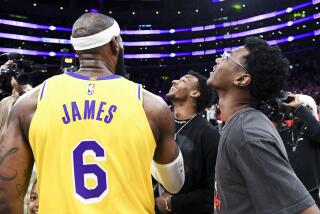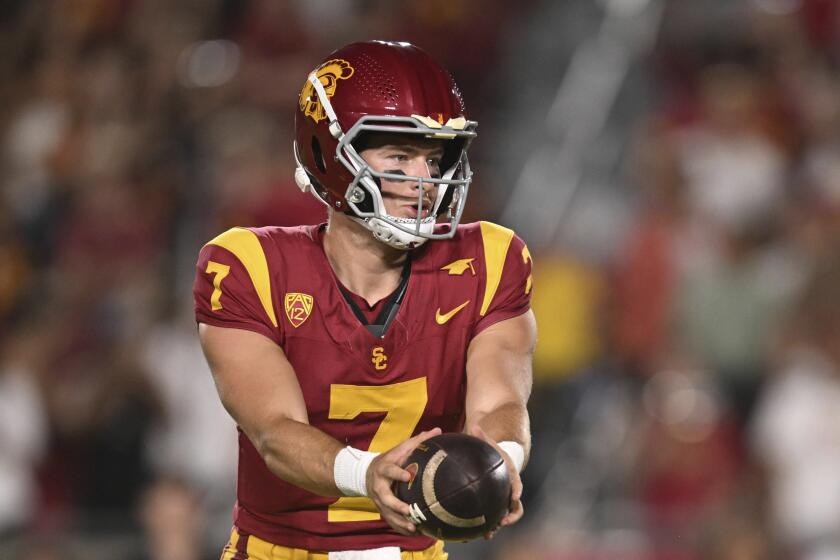TV, sweet TV
IT’S not too late to snag a great seat for Super Bowl XLII on Sunday. In fact, you may be sitting in it right now, remote control at hand and TiVo quivering in anticipation.
The Super Bowl is the television event of the year -- more than 93 million viewers in 2007 -- and threat of recession notwithstanding, more Americans will watch the game on new LCD and plasma screens than ever before. The majority of HDTVs sold these days are 40 inches or larger, and new 1080p screens deliver picture resolution that’s six times better than analog sets from a decade earlier. Talk to enough football fans and it’s no wonder many say they would prefer to watch the big game on TV rather than in person. A recent survey conducted for Motorola said the country was almost evenly split. Is it only a matter of time before television eclipses real life?
Researchers at UC San Diego and the University of Melbourne in Australia unveiled new broadband technology this month that included giant screens with resolution 50 times higher than any HDTV available commercially today. In Japan, Sony has premiered a sparkling clear screen illuminated by light emitting diodes, and later this year Mitsubishi plans to sell a TV whose astonishing imagery is painted by laser light.
All this technological change means football is no longer just a game of inches but of lines of resolution. Hulking linebackers and fleet-footed wide receivers practically crash through those epic screens, each tackle rendered in bone-rattling surround sound, each stunning reception delivered in blazing high definition.
“Even at the stadium you end up watching it on a giant television anyway. Our life is so mediated nowadays,” says Jon Alain Guzik, editor of driverside.com. He recently moved from Los Angeles to San Francisco and is planning to buy a 52-inch LCD for his Super Bowl party.
“I would like to watch the game live, but having bad seats at sporting events and having to deal with all the junk that goes with it is not much fun. And you never know what’s going on,” says Guzik, who takes a radio to baseball games so he can follow the action better.
A large HDTV in a relatively small room can indeed give the feeling of “being there,” says Robert Kubey, director of the Center for Media Studies at Rutgers University (and owner of a 40-inch LCD). New TVs actually can affect how much our eyes move to track action, he says.
“When you see a theatrical play or sporting event -- anything live -- you are deciding where to look,” he says. “With [analog] TV you are directed where to look, but with HDTV you can search more of what is interesting on the screen.”
Screens within screens, slow-motion and endless replays enhance the experience in a way that spectators in the stands can’t deny.
“The first time I went to a live professional sporting event was a Bulls game, preseason,” says Cheryl Cooky, a Cal State Fullerton assistant professor of kinesiology. “I had 13th row seats and was really psyched.”
But deprived of the play-by-play and color commentary to which she had grown accustomed, not to mention the close-up camera work, the quick cuts, the instant statistics and all the other benefits of her 42-inch plasma equipped with TiVo . . .
“My response was, ‘This is so boring,’ ” she says.
IMPROVED televisions hardly seem like harbingers of social change, but this technological evolution very well may alter how some people spend their time and relate to others.
If a football game or movie is exponentially better when viewed at home than in a stadium or theater, are we more likely to withdraw into our own private worlds? If a new generation of viewers grows up watching TV on some high-definition cellphone of the future, will fewer families gather around the big set together?
Though researchers are just beginning to study the effect of HDTV on human behavior, the new technology represents what sociologists call the privatization of leisure: People are less likely to seek entertainment in public social settings.
What’s complicating the outlook for the future, UCLA sociology professor David Halle says, is the Internet.
“While people are watching their HDTV, they’re also text-messaging their friends. This is not privatization in the old sense, but now in context of this tremendous web of relationships.”
In many ways the Internet has boosted social interaction, Halle says. It’s just a different form of interaction.
Take the Super Bowl. Part of its appeal for many people, of course, is the social element.
The Super Bowl has become a quasi-holiday with its own foods, drinks and rituals. It’s the last party of the holiday season. Best of all, there are no family obligations.
Tony “The Goose” Siragusa was an NFL defensive lineman for 12 years and played on the Baltimore Ravens’ 2001 championship team. Now co-host of the DIY Network’s “Man Caves” show, he says he’d rather watch the game at home with buddies in his basement (120-inch high-def projection screen, bar, full kitchen with a Viking stove, fireplace).
“I like the energy that’s generated in a stadium, but I also like the comforts of being at home and being able to eat whatever I want and not have to look for the popcorn guy,” he says.
“If I had my choice, I’d be sitting on the 50-yard line with a 50-inch plasma in front of me. It is better on TV.”
Does this mean the live audience is destined to wither?
“People love the live-audience experience,” media-studies expert Kubey says. “There’s nothing like getting up at the end of a great play and giving a standing ovation. You just can’t do that alone in your home.”
Laura Hawk, a recent Cal State Los Angeles graduate now living in Wisconsin, always goes to Green Bay Packers games even though her basement holds a 100-inch projection screen with surround sound as well as a 60-inch flat screen.
The weather can be brutal, but for Hawk, football is part of the family business. Her brother is former Notre Dame star and Cleveland Browns backup quarterback Brady Quinn, and she’s married to Green Bay linebacker A.J. Hawk.
“There’s nothing like being in the stadium and seeing it live,” she says.
“You’re up, you’re down, your emotions are all over the place. It feels like you can have control of the game if you’re there, like you can make a difference by cheering louder.”
One person who is seeing Super Bowl XLII in person is Jackie Agenbroad of Litchfield Park, just west of Phoenix. She won two seats -- end zone, third level -- in a drawing by the Arizona Super Bowl Host Committee. The tickets’ face value: $1,400.
“I haven’t had anybody want to buy them,” she says. “But my husband says if we get the right offer, maybe we should.”
Not a bad idea. Agenbroad could buy a pretty good 42-inch flat screen for that much.
--
More to Read
Get our high school sports newsletter
Prep Rally is devoted to the SoCal high school sports experience, bringing you scores, stories and a behind-the-scenes look at what makes prep sports so popular.
You may occasionally receive promotional content from the Los Angeles Times.






